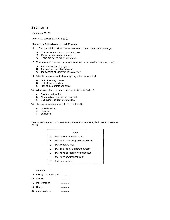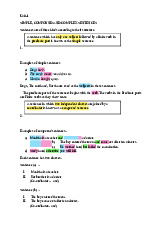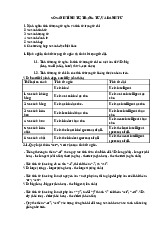






Preview text:
READING B PASSAGE 6
If we took a look at how people in Europe communicated just one hundred years ago, we would be very
surprised to find out that English was hardly used outside the United Kingdom. The language most
commonly used between people of different nationalities, and particularly the aristocracy, was French.
In fact, French was the language of diplomacy, culture and education. However, that is not the case
nowadays. English has replaced French as the international language of communication. Today there are
more people who speak English as a second language than people who speak it as a first language.
There are many reasons why English has become the language of international communication.
Britain's colonization of many parts of the world had something to do with it, but it is mainly due to
America's rise to the position of major world power. This helped spread popular American culture
throughout the world bringing the language with it.
But is it good that English has spread to all parts of the world so quickly? Language specialists seem to
be divided over this issue. There are those who claim that it is important to have a language that the
people in our increasingly globalized world have in common. According to others, English is associated
with a particular culture and therefore promotes that culture at the expense of others. Linguists have
suggested "Esperanto", an artificially put-together language, as a solution to international
communication problems but without success. So, English will continue being the world language until
some other language, maybe Chinese, which is the most widely-spoken native language in the world,
takes over as the world's international language instead of English.
1. According to the passage, a century ago….
A. educated people throughout Europe spoke English.
B. foreign travelers to England spoke only French.
C. French was much more popular than English.
D. only the French aristocracy could speak English.
2. What is chiefly responsible for the growth in popularity of English?
A. Britain's becoming an international power.
B. The French losing many colonies.
C. America's becoming powerful.
D. The development of American culture.
3. What is meant by "the language of diplomacy" (lines 4)?
A. The language used by ordinary people.
B. The language used by the English and the French.
C. The language used by the aristocracy.
D. The language used by governments.
4. What is true according to the passage? A.
The experts don't like Esperanto.
B. Esperanto is difficult to learn.
C. Esperanto is not a natural language
D. Esperanto is becoming more and more popular.
5. The experts' opinion on the spread of English is ….. A. split B. positive C. negative D. undecided
6. The author believes that …..
A. English is easier to learn than Chinese.
B. English will probably be replaced as an international language.
C. Chinese is going to be the next language of international communication.
D. Chinese is growing in popularity among non-native speakers.7. These days ……
A. French is the language of diplomacy.
B. more non-natives speak English than natives.
C. more people speak French than English.
D. French is a dying language.
8. What would be a good title for this passage?
A. English; Past, Present and Future
B. English as an international Language
C. English language means English culture
D. English: a difficult language to learn PASSAGE 7
The term "dyslexia" is used to describe a number of problems associated with reading, writing or
spelling. Short-term memory, mathematics, concentration, personal organization and sequencing may
also be affe ^ted. We do not know exactly what causes dyslexia, but we do know tha. it tends to run in
the family. We also know that more boys suffer from dyslexia than girls and that dyslexia is more
common in urban areas than in rural.
One of the most common signs of dyslexia is "reversals". People with this kind of problem often confuse
letters like "b" and "d" when reading and writing or they sometimes read and write words like "tip" and
"won" as "pit" and "now". Other common characteristics are lack of punctuation, misspelling, mixed-up
sentence structure and poor grammatical construction.
People are born with dyslexia, but it is only when they begin to learn to write that it becomes a
noticeable problem. For children with dyslexia, going to school can be a traumatic experience. Poor
achievement can make them feel frustrated and insecure. They are reluctant to go to school and
sometimes even skip school altogether. Cheating, stealing and experimenting with drugs can also occur
when children regard themselves as failures.
It is a common misconception that dyslexic people are of inferior intelligence. Yet Albert Einstein,
Leonardo da Vinci, Thomas Edison and Hans Christian Andersen were apparently all dyslexic. There is
no total cure for dyslexia; however, the effects of dyslexia can be lessened with the guidance of skilled
specialists and a lot of determination.
1. When does it become apparent that a child may be suffering from dyslexia? A. when they are born
B. when they begin their education
C. when they use symbols instead of words D. when they start talking
2. According to the passage, dyslexic children
A. might have behavioral problems. B. end up taking drugs.
C. look forward to going to school. D. do well at school.
3. The passage states that one common characteristic of dyslexics is that they...
A. have difficulty expressing their feelings.
B. are not able to read three-letter words.
C. have difficulty learning the letter "b". D. read words backwards.
4. The purpose of this passage is to inform readers that
A. Albert Einstein was dyslexic.
B. it is difficult for dyslexics to get professional help.
C. dyslexics are as intelligent as other people.
D. dyslexics are inferior to other people.
5. Who is more likely to be dyslexic? A. girls
B. children who live in the country
C. children who are not bright
D. children whose parents are dyslexic
6. How can the effects of dyslexia be made less severe?
A. by learning to live with them
B. by learning a special skill
C. with professional help and hard work
D. by learning how to deal with failure
7. According to the passage, which of the following is true?
A. Dyslexia refers to a specific learning disability.
B. Dyslexic people become famous.
C. Dyslexia affects only reading and writing skillsD. The causes of dyslexia haven't been fully explained. PASSAGE 8
Back in 1853, at the age of 24, Levi Strauss opened a west coast branch of his brother's dry goods
business in New York. Over the next twenty years, he built his business into a lucrative operation.
One of Levi's customers was a tailor by the name of Jacob Davis. Originally from Latvia, Jacob lived
in Reno, Nevada, and regularly pur-chased bolts of cloth from Levi Strauss & Co. Among Jacob's
customers was a man who kept ripping the pockets on the pants that Jacob made for him. Jacob tried to
find a way to strengthen his customer's pants when, one day, it finally occurred to him. He decided to
put metal rivets on the pocket corners and at the base of the button fly. It worked and the pants became an instant success.
Jacob knew he had discovered something new and worried that someone might steal his idea. That's
why he decided to apply for a patent, but he didn't have the $68 that was required for the paperwork. So,
he turned to Levi Strauss. He wrote him a letter suggesting that they hold the patent together. Being the
businessman that he was, Strauss agreed immediately seeing the potential for this new product. So, on
May 20, 1873, the two men received patent number 139,121 from the US Patent and Trademark Office
and went into business together. That was the day blue jeans were born. Who would have thought back
then that denim, thread and a little metal would become the most popular clothing product in the world
and it's all thanks to two men - Levi Strauss and Jacob Davis.
1. According to the passage, why did Jacob write to Levi? A.
He didn't have the necessary funds to get a patent.
B. He didn't know how to apply for a patent.
C. He had no one else to turn to.
D. He knew Levi had the right connections.
2. Which of the following titles best summarizes the content of the passage?
A. The Beginning of a Successful Partnership B. The History of Jeans C. How Jeans Were Invented
D. The Lives of Levi Strauss and Jacob Davis3. According to the passage, what happened in 1853?
A. Levi set up a business with his brother,
B. Levi moved to the west coast.
C. Levi became a successful businessman.
D. Levi started working on his own.
4. What is true about Jacob Davis?
A. He He was Levi's customer in Latvia. B.
He was Levi's business partner, C. He was Levi's tailor. D. was Levi's friend.
5. Why did Jacob'put metal rivets on the pants he made?
A. because his customers asked for it
B. because he wanted to prevent something from happening C. because it was fashionable
D. because he wanted to do something different
6. Why did Levi accept Jacob's offer?
A. because he knew it would pay off
B. because his business was in trouble
C. because he was looking to expand his business
D. because Jacob was a good customer7. In 1873, Levi and Jacob…… .
A. founded their first company.
B. applied for a patent number.
C. made their first blue jeans. D. got their first customers. PASSAGE 9 PROTECT OUR PLANET WITH CAT!
Back in the 1960s and 70s, the world was becoming more aware of the destructive effects of industry
on the environment and people were starting to think seriously about ways of protecting the environment.
One man who was particularly affected by this subject was Gerard Morgan-Grenville. As Morgan-
Grenville travelled round earning his living as a gardener, he noticed signs of the damage that was being
done to the countryside around him. It wasn't long before Morgan- Grenville decided that he had to do
something about this situation. He felt that if people could be shown a better way of living then maybe
they would be interested enough to try to protect their precious environment.
Mr Morgan-Grenville decided to set up a project that would prove what was happening to our
surroundings and what could be done about it. So, in 1975, Morgan-Grenville created the Centre for
Alternative Technology (CAT) in a village in Wales. The main aim of CAT is to search for an
ecologically better way of living by using technology that does not harm the environment. One of the
most important things CAT did initially was to explore and demonstrate a wide range of techniques and
to point out which ones had the least destructive results on the world around us. It is also very important
for CAT to provide information and advice to people all over Britain and all over the world. If more and
more individuals are informed about how much damage our modern lifestyle is doing to the planet,
maybe more of them would be prepared to look for solutions.
The point about CAT is that by combining theoretical and practical ideas, it has shown ways in which
people, nature and technology can exist together successfully. CAT now covers many themes, including
energy-saving techniques, good use of land, the correct management of waste products, recycling and
health and food issues. Visitors to CAT are able to observe many new ways of living, all of which are
ecologically correct and use up less of our valuable raw materials. For example, the sewage systems at
CAT that get rid of all the waste from the kitchens and bathrooms are organised so as to be completely
environmentally friendly, and much of the energy used at the centre is created by power from the sun,
wind or rain. In addition, all the building methods used are ecologically ideal and no chemicals are used
at the centre; for instance, no chemicals are used in gardening or cleaning. Every-thing is based on the use of natural products.
One major global problem is the damage done to the whole planet by the effects of industry. Problems
such as global warming, the holes in the ozone layer, the destruction of huge areas of forests, and
pollution in our atmosphere are all connected to the fact that there is an increase in industry. Now, at last,
this problem is being recognised worldwide.
People now agree that we want clean air, pure drinking water, safe sunlight and healthy food. What
CAT is trying to do is to demonstrate that we can have all those things without the environment paying
the price. Slowly, CAT is communicating its message to countries across the world. In Europe, several
countries have set up similar ecological centres to look at alternative environmentally friendly
technology. The workers at CAT hope that one day there will be so many centres all over the world that
governments and managers of industry will start to change their ideas and will think more carefully
about the environment. Once this happens, the possibilities for protecting our beautiful planet will be endless.
1. Mr Morgan-Grenville was worried about….
A. the damage his gardening was doing to the countryside.
B. the countryside being harmed.
C. people protecting the environment.
D. what he did for a living in the countryside.
2. One of the main aims of CAT is ….
A. to use better technology to harm the environment.
B. to use less technology in the environment.
C. to stop using technology that does not harm the environment.
D. to use technology that causes less damage to the environment.
3. Which one of the following statements is true?
A. CAT uses a mixture of theory and practice to explain its message.
B. CAT only uses practical solutions to explain its message.
C. CAT has demonstrated how successful its theories are.
D. CAT believes it would be better if technology didn't exist.
4. Visitors to CAT ….
A. can use valuable raw materials.
B. are all ecologically correct.
C. can see new ideas in practice.
D. can see valuable raw materials.
5. The increase in industry worldwide….
A. has led to an increase in environmental problems.
B. is due to the damage done to the whole planet.
C. is a result of efforts to protect the environment.
D. has been caused by problems like global warming.
6. The workers at CAT are hoping …..
A. that their managers will start to change industry.
B. that their ideas will be used all over the world.
C. that our beautiful planet will end.
D. that it can protect governments and managers worldwide. PASSAGE 10 AN UNWELCOME GUEST
Of the one in seven people in the UK who claim to have seen a ghost, the majority are women. This
may be because women have far more association with the spirit world. Women trust their emotions and
are generally better able than men to cope with the unexpected.
Housewife Fiona Blair describes herself as very practical and down-to-earth, and never believed in the
idea that a house could be haunted. That all changed when she and her family moved into a manor house
in the Midlands. Although the surveyor reckoned that the house re-quired a lot of attention and was
somewhat damp, they thought it was stunning. They could just afford it and it would be a good
investment, so they took the plunge and decided to buy it.
Nonetheless, right from the start, Fiona had a strange sense that they were not alone in the house. One
of her teenage daughters had left a towel over the back of a chair in the kitchen. Fiona was in the garden,
and when she returned to the house, the towel was over the kitchen table like a tablecloth. On other
occasions the family would find that objects such as glasses and vases had been turned upsidedown.
This was only the start of the peculiar happenings. A particularly strange incident happened on Fiona's
birthday. Fiona's husband, Mark, came home from work and went into the living room. He immediately
came rushing out to ask who had bought her the beautiful flowers -but nobody had given Fiona flowers
and her daughters had not put the flowers there. It remained a mystery how they had miraculously appeared.
Fiona was curious and decided to find out about the history of the house. What she discovered was
rather alarming. Apparently a young girl, servant to a previous generation of owners, had been found
dead in peculiar circumstances in the attic. Fiona and her family inevitably began to feel claustrophobic
and trapped in the house, and eventually decided that they would have to move.
Unfortunately, things were not as simple as that. Each time they at-tempted to show the house to
potential buyers, Fiona would of course ensure beforehand that everything was neat and tidy in order to
make a good impression. But by the time anyone arrived, the entire house would be in a complete mess,
and visitors complained of an unpleasant atmosphere. Eventually, after many months, an American
couple viewed the house, and decided it had a certain attraction. For some reason, the ghost did not play
its usual tricks, and Fiona was able to sell what had been her dream home.
Now living in a spacious modern apartment in London, Fiona wants to forget it all and move on with
her life. "At one point I thought I might be going out of my mind, it was all so frightening. We can almost
laugh about it all now, but I hope we never experience anything like that again.
1. Why did the writer and her husband want to move into the house in the Midlands?
A. They were eager to find out if it had a ghost.
B. They were attracted by the appearance of it.
C. They knew someone important had lived there.
D. They werejooking for a house to modernise.
2. After they moved in, they ….
A. began to hear strange noises in the attic.
B. realised that the house was incredibly cold.
C. discovered that objects were being moved. D. broke a lot of glasses.
3. What happened on Fiona's birthday?
A. Her daughters bought her flowers.
B. There was an unexplained occurrence.
C. A burglar broke into the living room.
D. Mark forgot to buy a present.
4. What had happened to the servant girl?
A. She had killed herself in the attic.
B. She was murdered by the owners.
C. She had been locked in the attic. D. She died in the house.
5. What did the ghost do when they decided to sell the house?
A. It disappeared immediately.
B. It made people viewing it feel unwelcome. C. It tidied the house. D. It made horrible noises.
6. What does "it" (first sentence of the last paragraph) refer to? A. the house she lived in B. the modern apartment C. the experience she had D. the sale of the house




